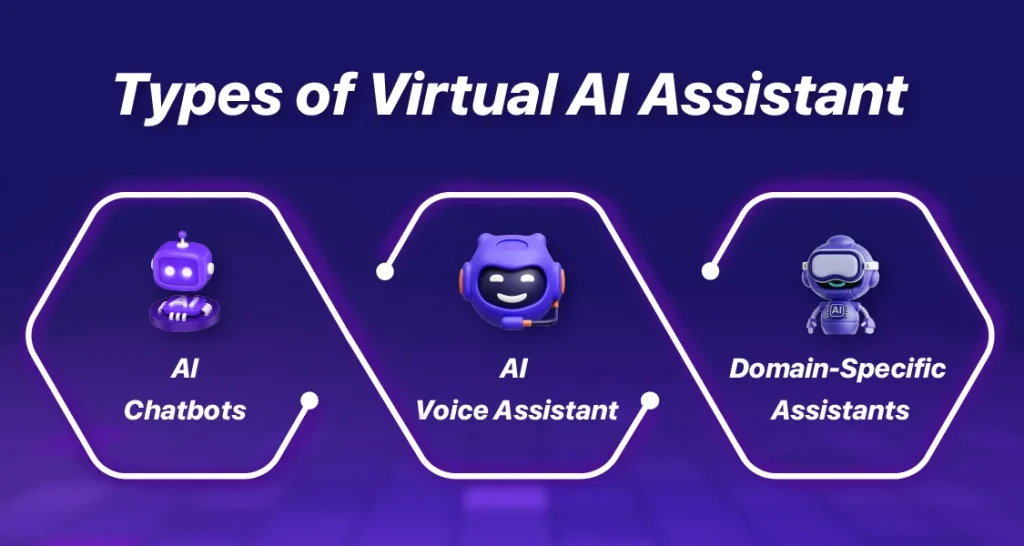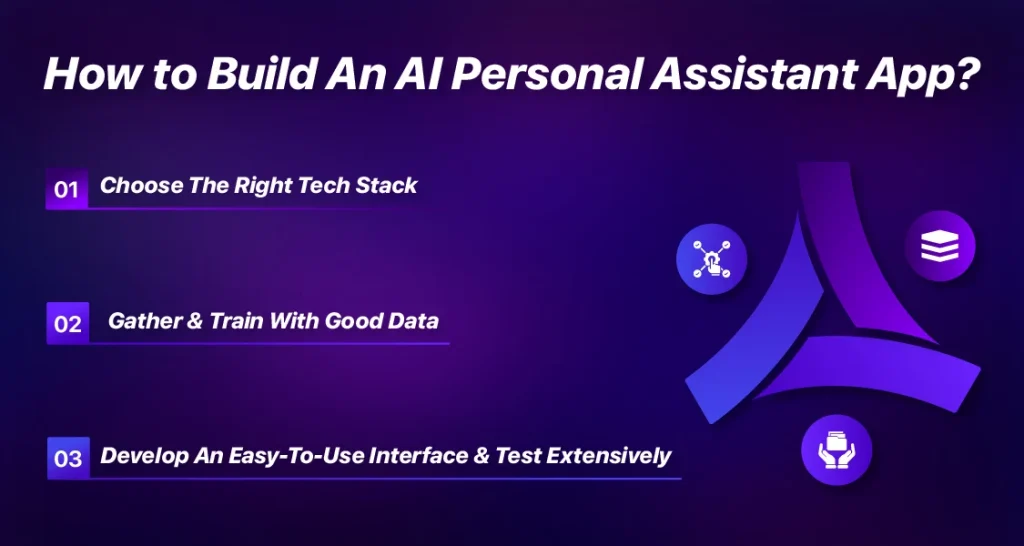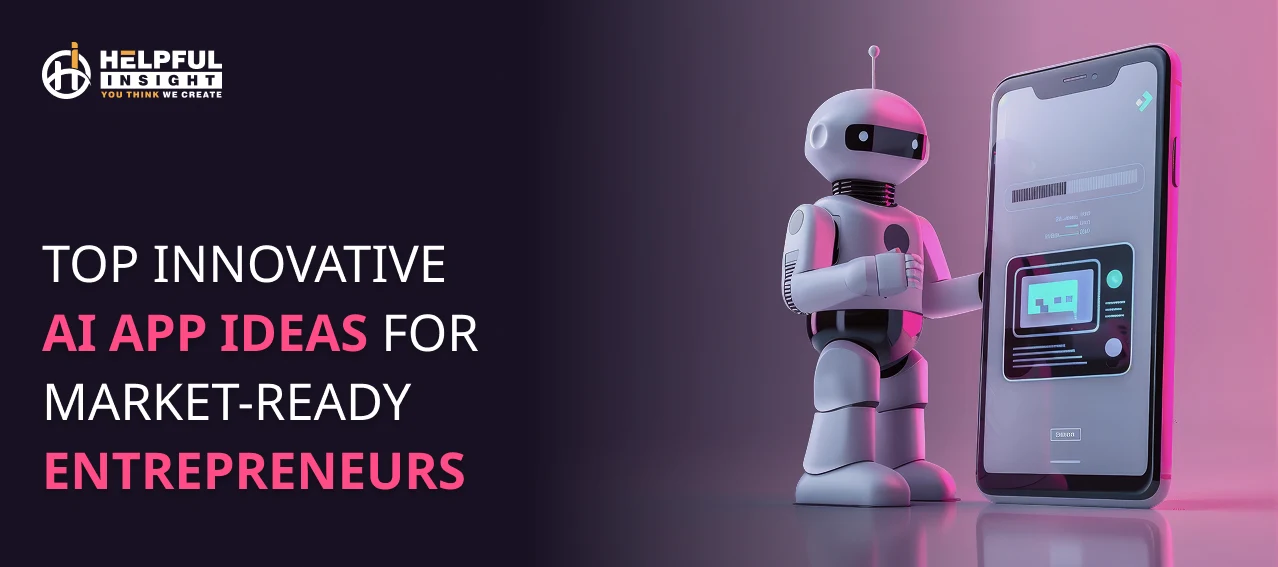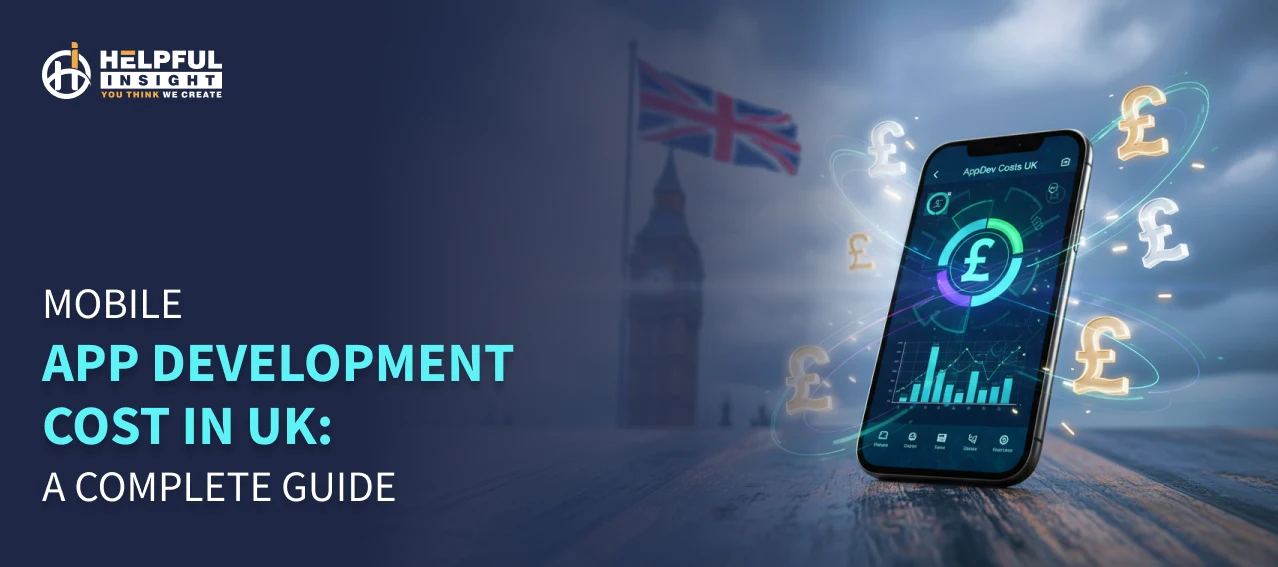As we all know, the Tech world is growing with unmatchable speed, and you are witnessing changes all the time. The newest change is artificial intelligence. Narrowing down to AI personal assistant app development that only shows the pioneer of new tech but also brings utility to the customers or even in everyday life. Keep reading this guide to discover how artificial intelligence assistants can be the next power move your business needs. Get an idea on core Al functionalities to navigate the complexities of UXR, with intent of bringing knowledge and insights required to excel in the dynamic field of Al personal assistant app development, keep reading.
What is an Al Personal Assistant App?
An Al personal assistant app is nothing but a tool or a platform that utilizes artificial intelligence technologies to accomplish various tasks through a conversational interface.
These virtual assistants work on natural language processing (NLP), machine learning, and speech recognition to understand what is asked and what is the most humane way to deliver the task: This advanced interaction and ease of use feature them apart from the generic softwares, making them better companions in both personal and professional settings.
Key Features
All personal assistants work on one single aim that is enhancing user experience and productivity. They are capable of understanding regular conversations, compatible to process and interpret human speech or text input accurately. As they understand the context, awareness enables them to generate appropriate responses based on user data and previous interaction, ensuring a hyper customised experience. To make things better, they can automate routine tasks, support data-driven decision-making, and improve overall workflow efficiency, addressing a variety of user needs.
Applications and Use Cases
AI personal assistants are used in various industries, expanding their reach and convenience. Particularly in the sectors like healthcare, they are relied on for developing patient summaries and medication reminders. In manufacturing and retail, they optimize production activities and facilitate predictive maintenance. Retail industries use them to enhance customer satisfaction via recommendations and optimized stock handling. Recently it has proven success in departments like human resources, education, finance, and customer support, always changing activity conduct.
Types of Virtual AI Assistant

1. Al Chatbots
Al chatbots are computer applications that communicate with users in the chat manner. They apply natural language processing and machine learning to comprehend and generate inputs accordingly. Chatbots are seen mostly on the websites, social media, and messaging apps to support 24/7 or help users with the requested information. The simplicity of use and availability of chatbots makes them a great fit for answering FAQ and providing basic information like payment links or scheduling tasks.
2. Conversational Agents And AI voice assistant
Conversational agents such as ChatGPT and AI voice assistants like Alexa go beyond text-based communication by incorporating voice input and thus offering more human interaction. They are better in grasping sophisticated language structures and distinguishing user purpose, which allows more sophisticated and interactive dialogue. Conversational agents find application in virtual customer service, making user interaction easier through relevant and personalized responses.
3. Domain-Specific Assistants
Industry-specific virtual assistants are specific to meet the needs of particular industries or uses such as healthcare, finance, or tourism. They are designed virtual assistants to perform functionalities such as generating personalized travel plans or providing investment advice. They can generate extensive knowledge and expertise by targeting a specific domain, thus making user experience and decision-making easier.
Read Also:- How to Hire AI Developers: Step-by-Step Guide in 2025
Why Invest in an Al Personal Assistant App?
1. Boost Business Efficiency
Investing in an Al assistant app is the best way to boost business efficiency by automating repetitive tasks and streamlining operations. To boost productivity automate the day to day tasks that are almost brainless such as reminders, data management, and marking attendance. By reducing reliance on manual processes, businesses can take a step towards productivity and integration of technology in day to day.
2. Enhanced User Engagement
Artificial intelligence virtual assistant apps can significantly increase user engagement by providing personalized and context-awareness. These apps work on advanced natural language processing and machine learning algorithms to read and respond like humans but in a faster and factual way, thus increasing user satisfaction and retention rates.
3. New Revenue Streams
Developing an artificial intelligence personal assistant can open new revenue streams through creating options like premium features and subscription models. Businesses can monetize advanced functionalities such as customised recommendations and integrations with smart home devices. As the world is adapting more and more AI assistants, the market continues to grow and tapping into this opportunity can provide a first mover advantage.
Top Benefits of Virtual Ai Assistant
>Continuous Availability
One of the features that beats humans is 24/7 availability. You can expect AI personal assistant app to perform tasks even when shift is over. This continuous availability leads to no delay and customer retention, enhancing brand image.
>Cost Efficiency and Scalability
Integrating an intelligence virtual assistant can eliminate the need of hiring a dedicated developer team providing lesser operational cost. Moreover, It’s a smart choice as this can high volumes of customer’s requests, offering scalability that aligns with fluctuating business demands. This flexibility makes AI personal a better choice for the budding startups and businesses.
Tech Stack of Al Personal Assistant App Development
Al & Machine Learning
An AI personal assistant’s success is based on picking the best technology and machine learning tools. Widely accepted options are – TenserFlow and PaTorch for developing and deploying machine learning models. These models are best in industry, trust them to get the most from learning and adapting to user interactions. Pair it with OpenAl’s GPT and IBM Watson for advanced natural language understanding capabilities, key factors for intuitive user experiences.
Natural Language Processing (NLP)
NLP is also instrumental in enabling the AI assistant to understand what is the context of conversation. Google Dialogflow and Amazon Lex provides ease for the conversational interfaces through pre-trained models and glitch free integrations. Mobile app development company who are looking for control and customization, Rasa is the best option in the open-source category that helps developers to create advanced dialogue systems specific to AI powered virtual assistants.
Backend Infrastructure
Behind the scenes, a robust backend is the backbone of any best AI personal assistant. Rely on Node.js, Python and frameworks such as Flask or Django, for flexibility and capability required to process data and deal with API requests effectively. Cloud platforms like AWS, Google Cloud, and Microsoft Azure secure scalable, and reliable hosting alternatives with your app’s requirements.
Real Also:- How Much Should You Budget for AI and Machine Learning Integration in Your App?
How to Build An AI Personal Assistant App?

Understand and figure out what problem your AI virtual assistant is solving. How is it adding value in a consumer’s life? Whom is it assisting? Whether you provide solutions to engineers, create essays for fifth grade students, or explain cake recipes to 50 year old ladies, a strong aim will assist in determining functionality to user interface.
1. Choose the Right Tech Stack
We can’t emphasize enough the importance of the right tech stack. The first step is choosing the programming languages, frameworks, and development tools that aligns with the objective of developing the best AI personal assistant . As per our understanding Python and JavaScript are good choices for AI projects. For further advancement check – TensorFlow or PyTorch to assist with model training and performance tuning.
2. Gather and Train with Good Data
The best AI assistant becomes leading only when it’s trained nicely. You can begin your journey by employing a different, diverse and relevant dataset, and refine it as many times needed to create a polished outcome, and with the help of transfer learning enhance existing models. As your model grows older, continue testing and training so it doesn’t go obsolete. Take inspiration from google assistant ai.
3. Develop an Easy-to-Use Interface and Test Extensively
The interface must be intuitive and easy to use, regardless of whether users are communicating through voice or text. Prioritize making the experience smooth and natural. Once the design is complete, test it extensively not only for bugs, but also for usability and performance. When everything is good, go ahead and ship. Don’t forget to collect user feedback and continue to improve the app based on what they experience.
Read Also:- Charting the Course: 2025’s Most Popular Mobile App Categories Revealed
How Much Does It Cost to Develop An Ai Assistant App?
Building an Al assistant application has various elements that contribute to the final cost. Important aspects are the sophistication of the Al features, platforms to be supported (like iOS, Android, or web), and size of the application. The location and skill of the development team, technology stack adopted, and infrastructure requirements for data also significantly impact the cost.
Estimated Cost Breakdown to Develop an AI Assistant App
| Component | Task Description | Estimated Hours | Rate (USD/hour) | Cost Range (USD) |
| 1. Planning & Research | Defining goals, features, user flow, tech stack | 40–60 hrs | $50–$100 | $2,000–$6,000 |
| 2. UI/UX Design | Wireframes, user journeys, visual design | 60–100 hrs | $50–$120 | $3,000–$12,000 |
| 3. Frontend Development | Mobile or web interface using Flutter, React Native, or native SDKs | 120–200 hrs | $50–$120 | $6,000–$24,000 |
| 4. Backend Development | Server-side logic, APIs, database integration using Node.js, Python, etc. | 150–250 hrs | $60–$130 | $9,000–$32,500 |
| 5. NLP & AI Integration | Integrating NLP services (Dialogflow, Lex, Rasa); training models, fine-tuning | 120–180 hrs | $80–$150 | $9,600–$27,000 |
| 6. Voice Integration (optional) | Voice recognition and speech synthesis (using Google, Amazon Polly, etc.) | 60–100 hrs | $80–$150 | $4,800–$15,000 |
| 7. Data Collection & Training | Preprocessing, labeling, and training datasets | 80–120 hrs | $70–$140 | $5,600–$16,800 |
| 8. Testing & QA | Functionality, performance, usability, and bug testing | 60–100 hrs | $40–$100 | $2,400–$10,000 |
| 9. Deployment | Publishing on cloud (AWS, Azure, etc.), app stores | 20–40 hrs | $50–$100 | $1,000–$4,000 |
| 10. Ongoing Maintenance | Bug fixes, updates, server management (per month) | 20–40 hrs/month | $40–$100 | $800–$4,000/month |
Other Potential Costs
| Item | Estimated Monthly/Annual Cost |
| Cloud Hosting (AWS, GCP) | $100–$1,000/month (depends on traffic, usage) |
| NLP Services (Dialogflow, Lex) | Free to $500+/month (based on usage/tier) |
| Voice APIs (e.g., Google STT) | $4 per 1,000 minutes or more, depending on usage |
| Third-party APIs | Varies by provider; some charge per API call |
| App Store Fees | $99/year (Apple) + $25 one-time (Google Play) |
Conclusion: Build Smarter with Helpful Insight
Developing an AI personal assistant app is all about collaborating smart tech with requirements of the user. NLP integration to backend development, each phase has its importance. Consult with Helpful Insight, we turn your vision into a customized app development solution powered by AI, quick to develop, scalable, and as per the industry requirements. Experience the future of technology with us.
FAQS
Ans. A good AI personal assistant app must provide functionality that is congruent with its fundamental purpose. Shared functionalities include natural language interpretation (text and/or voice), task scheduling, reminders, smart search, third-party service integration and calendar integration (such as email or weather), and personal recommendations.
Ans. Not quite. Most tools such as Dialog Flow, Amazon Lex, or Microsoft Bot Framework have pre-existing NLP models that can serve to perform many common conversational tasks without you having a dedicated machine learning team. But if you’re developing a highly custom or domain-specialized assistant or training your own models for more advanced tasks like intent recognition or sentiment analysis then having data scientists or ML engineers on hand matters.














